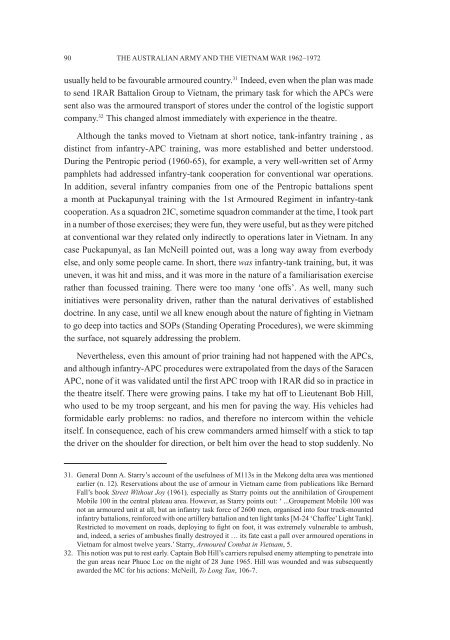conference proceedings - Australian Army
conference proceedings - Australian Army
conference proceedings - Australian Army
Create successful ePaper yourself
Turn your PDF publications into a flip-book with our unique Google optimized e-Paper software.
90<br />
THE AUSTRALIAN ARMY AND THE VIETNAM WAR 1962–1972<br />
usually held to be favourable armoured country. 31 Indeed, even when the plan was made<br />
to send 1RAR Battalion Group to Vietnam, the primary task for which the APCs were<br />
sent also was the armoured transport of stores under the control of the logistic support<br />
company. 32 This changed almost immediately with experience in the theatre.<br />
Although the tanks moved to Vietnam at short notice, tank-infantry training , as<br />
distinct from infantry-APC training, was more established and better understood.<br />
During the Pentropic period (1960-65), for example, a very well-written set of <strong>Army</strong><br />
pamphlets had addressed infantry-tank cooperation for conventional war operations.<br />
In addition, several infantry companies from one of the Pentropic battalions spent<br />
a month at Puckapunyal training with the 1st Armoured Regiment in infantry-tank<br />
cooperation. As a squadron 2IC, sometime squadron commander at the time, I took part<br />
in a number of those exercises; they were fun, they were useful, but as they were pitched<br />
at conventional war they related only indirectly to operations later in Vietnam. In any<br />
case Puckapunyal, as Ian McNeill pointed out, was a long way away from everbody<br />
else, and only some people came. In short, there was infantry-tank training, but, it was<br />
uneven, it was hit and miss, and it was more in the nature of a familiarisation exercise<br />
rather than focussed training. There were too many ‘one offs’. As well, many such<br />
initiatives were personality driven, rather than the natural derivatives of established<br />
doctrine. In any case, until we all knew enough about the nature of fighting in Vietnam<br />
to go deep into tactics and SOPs (Standing Operating Procedures), we were skimming<br />
the surface, not squarely addressing the problem.<br />
Nevertheless, even this amount of prior training had not happened with the APCs,<br />
and although infantry-APC procedures were extrapolated from the days of the Saracen<br />
APC, none of it was validated until the first APC troop with 1RAR did so in practice in<br />
the theatre itself. There were growing pains. I take my hat off to Lieutenant Bob Hill,<br />
who used to be my troop sergeant, and his men for paving the way. His vehicles had<br />
formidable early problems: no radios, and therefore no intercom within the vehicle<br />
itself. In consequence, each of his crew commanders armed himself with a stick to tap<br />
the driver on the shoulder for direction, or belt him over the head to stop suddenly. No<br />
31. General Donn A. Starry’s account of the usefulness of M113s in the Mekong delta area was mentioned<br />
earlier (n. 12). Reservations about the use of armour in Vietnam came from publications like Bernard<br />
Fall’s book Street Without Joy (1961), especially as Starry points out the annihilation of Groupement<br />
Mobile 100 in the central plateau area. However, as Starry points out: ‘ ...Groupement Mobile 100 was<br />
not an armoured unit at all, but an infantry task force of 2600 men, organised into four truck-mounted<br />
infantry battalions, reinforced with one artillery battalion and ten light tanks [M-24 ‘Chaffee’ Light Tank].<br />
Restricted to movement on roads, deploying to fight on foot, it was extremely vulnerable to ambush,<br />
and, indeed, a series of ambushes finally destroyed it … its fate cast a pall over armoured operations in<br />
Vietnam for almost twelve years.’ Starry, Armoured Combat in Vietnam, 5.<br />
32. This notion was put to rest early. Captain Bob Hill’s carriers repulsed enemy attempting to penetrate into<br />
the gun areas near Phuoc Loc on the night of 28 June 1965. Hill was wounded and was subsequently<br />
awarded the MC for his actions: McNeill, To Long Tan, 106-7.

















